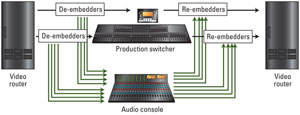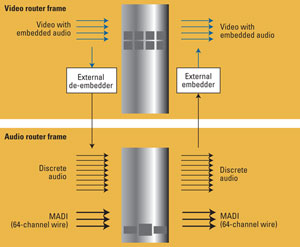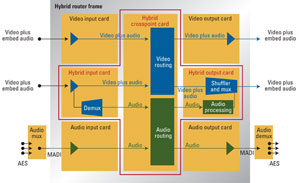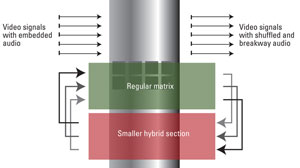Hybrid routing
Hybrid routing describes routers providing integrated, simultaneous switching of audio and video signals. Given the widespread adoption of embedded audio equipment, the vast majority of broadcast facilities have been designed and installed with minimal, if any, audio routing capacity.
Hybrid routers switch audio and video signals together, with nearly perfect time coherence — something most easily done in a single frame. Any contemporary router control system provides breakaway control of mono audio signals, stereo AES-3 signals, Dolby E and Dolby Digital signals. Using the hybrid approach, these control systems should become easier to configure and use.

Figure 1. With the move to HDTV and surround sound, video production facilities often require production switchers, audio-specific mixers or recording consoles.
The problem
Requirements to produce theater-quality surround sound have grown simultaneously with consumer adoption of HDTV programming. Providing this capability in video production facilities involves adding audio-specific mixing equipment, production switchers or even recording consoles. (See Figure 1.) It also requires monitoring equipment and listening areas to evaluate surround-sound quality, and the ability to switch and control mono audio channels, discrete AES-3 signals, AES-3 signals with non-PCM payload and possibly even MADI signals used for bulk audio transport. (See Figure 2.) This is a significant expenditure of time, capital and equipment room space if audio is not embedded.

Figure 2. Routing de-embedded discrete audio or bulk audio transport via MADI can take a significant amount of capital and rack space.
Modular equipment for embedding and de-embedding significantly reduces audio signal cabling but does not eliminate separate AES. This additional equipment also adds cost and consumes rack space.
Get the TV Tech Newsletter
The professional video industry's #1 source for news, trends and product and tech information. Sign up below.
Exact timing is required
Audio processing requires exact phase alignment of digital audio samples at 20.8µsec boundaries for 48kHz audio. Put differently, one sample of offset between two nominal 1kHz tones is equivalent to 7.5 degrees of phase offset error. HD-SDI embedded signals carry up to 16 mono channels of audio. MADI can carry 64. A final surround-sound program mix of six channels feeds the encoder. Often, 24 channels of audio, or more, are mixed down to the final six. Field recording for stage events requires audio consoles with multiple MADI I/O streams. Compared with traditional television sound, audio channel count has grown nearly tenfold and must all be perfectly aligned.
Ethernet is not perfect
Live production of audio and video signals requires near perfect alignment of audio with video and very low latency. Audio/video timing should be held to less than one video line of slip. Latency needs to be much, much lower than 1ms so that multipass processing does not generate lip-sync errors.
Hybrid routers typically range from 200 to 400 inputs by 500 to 1000 outputs. While Ethernet AVB approaches the timing metrics discussed, it presently does not scale to the sizes required. SMPTE 2022 has been recently expanded to include high-bit-rate video mapping into IP, but it fits better with contribution where FEC is necessary to correct errors from a noisy channel, rather than real-time production.
Baseband routing is a great solution
The perfect switch fabric is synchronous and deterministic for both audio and video. It preserves the installed, embedded infrastructure of existing facilities and trucks while accommodating AES-3, MADI and analog audio signals with minimal additional equipment. It is easily controlled by an intuitive router control system using traditional control panels supporting audio breakaway, which is exactly what baseband routers do.
How hybrids work
Hybrid router architecture follows the same general approach as traditional routers. What’s different is integrated signal switching. For example, consider a router frame with input, output and crosspoint cards. (See Figure 3.)
Input cards receive embedded SDI video. After cable equalization, signals are distributed to “on-card” de-embedders. They are also fed to the crosspoint. The de-embedders rapidly extract audio signals. Video inputs are assumed to be mutually timed to less than plus or minus one-half a line relative to each other and house clock. Each video input requires its own de-embedder. All de-embedded audio is then assembled and organized into a time-division multiplex (TDM) signal. For example, eight HD-SDI signals, each with 16 audio channels, yield one TDM stream with 128 mono audio channels. This audio TDM stream is then fed to its corresponding audio switch on the crosspoint card.

Figure 3. A hybrid router differs from a traditional router beause it integrates signal switching. Crosspoint cards switch audio and video while maintaining precise timing.
The result is that one crosspoint card now switches both the video and audio signals. Video is switched traditionally with a crossbar chip. Audio signals are switched in the time domain using shared memory architecture, typically implemented in an FPGA. It is critical that audio delay is minimized in this switch because video signals and audio TDM streams both feed the corresponding output card.
The switch card provides complete configuration flexibility. It receives either SDI or TDM audio and ensures they are routed to the correct switch chips based on signal type. Router input cards may be populated in any order or combination without respect to card type: hybrid, standard video or MADI. A crosspoint card with both video and audio switching on one module is easily and efficiently protected with an n+1 crosspoint protection scheme. One crosspoint card with both switch fabrics in a common audio-video frame ensures all timing requirements while providing robust, reliable switching.
It’s the output module that does the hard work. In addition to switched video signals, it receives TDM audio streams, which are demultiplexed and subsequently embedded into each video output. Each video signal is demultiplexed just enough to enable new audio signals to be switched into the correct time slot in compliance with SMPTE-standard embedding. This results in a combination of audio switching and embedding. The video signal is then scrambled, channel coded, reclocked and driven out of the router.
Ancillary data information for audio and video must be preserved. AFD and Dolby E burst preamble are two key examples.
Critical timing parameters
Minimizing delay is essential. With careful output embedder design, video delay can be just a few pixels. Conceptually, video data stays in the serial domain. Audio data is embedded bit by bit on the fly. Short video delays of much less than one-half a line greatly simplify plant timing, which is important for production. Audio delay is ideally as short, but the SMPTE standard dictates that audio samples always be embedded at the beginning of ancillary data space at the start of the video line. Audio samples are, therefore, delayed by one line.
The maximum audio delay results from different audio sample distributions across multiple lines of video. Differing buffer depths must be managed for each de-embedder and embedder in the router so that any mono audio signal de-embedded from any video signal may be embedded into a common video output. This results in a one-line minimum to two-line maximum delay. And, there is plus or minus one-half video line signal variance. The maximum delay is, therefore, a short three lines. Even multiple passes will not affect lip sync.
Production applications
Audio production benefits from hybrid routing. MADI is widely deployed and now supports 64 synchronous channels of 48kHz multiplexed into one 125Mb/s data stream. Today, production facilities lock all audio to 48kHz, and MADI provides signal timing coherence and minimal delay. For all these reasons, hybrid routers offer interoperability for embedded video, audio and MADI. The audio router switch is nonblocking, mono, full broadcast and covers every input from de-embedders, AES-3 and MADI to any output with audio capability.
Care must be taken to preserve multichannel phase coherence or audio image because embedded audio sample distribution will vary between video signals. Audio sample timing slips might be generated when switching audio from embedded inputs into embedded outputs. One audio sample time slip is a significant phase error, which degrades the surround sound image of program audio. Sixteen-channel audio embedders provide coherent image-accurate audio transport within one video signal. If more than 16 channels must be phase coherent, MADI is better.
A number of MADI products support sound stages, or remote microphone fields. These MADI signals are routed to an audio mixer, switched between MADI streams or switched into video as groups of 16 or eight channels. These switches are accurate. Phase coherence can be lost by switching audio from different videos into a common video signal. Fortunately, using multiple SDI video signals to transport image-accurate audio is not standard practice.
Dolby E is a common signal for production and needs to be handled correctly within a router. Ancillary data must be preserved, and it is essential that router switch points comply with SMPTE RP-168. Hybrid router internal audio delays as described are short enough to comply with Dolby E guard band specifications.
Hybrid ingest with DHP
Hybrid routing is popular for ingest because it affords complete flexibility to shuffle audio and actually route any de-embedded mono input to any other embedded mono output. Sixteen-channel audio alignment and assignment is, therefore, much simplified.
Dynamic hybrid pathfinding (DHP) provides affordable hybrid routing when only part of the router requires audio switching. Using this technique, one portion of the router contains hybrid inputs and outputs connected to sources that require frequent channel reassignment. Another smaller router partition is populated with more hybrid input and output modules, but these modules are fed by, and back into, the router. (See Figure 4.) This “pooled resource” topology is the same as if discrete de-embedders and embedders were configured in an external modular equipment frame. The balance of the router is filled with standard video and MADI input and output cards. This hybrid pooled resource is similar to tie lines between multiple routers and is managed with DHP.

Figure 4. Dynamic hybrid pathfinding (DHP) uses a smaller router partition for hybrid routing, and takes the place of discrete embedders and de-embedders.
It’s been shown that DHP can reduce router costs by 20 percent, partly by reducing the hybrid card count for the primary router. Additionally, the pathfinding hybrid cards are significantly less expensive than external equipment to achieve the same result. The resulting pooled resource provides mono audio routing between the Pool and Core routers. This is simply not possible with external embedders and de-embedders. That said, there is no free lunch. The Pool can be blocking, as is the case with tie lines, and the size of the pool is sized for expected use, which might occasionally be too small.
With DHP, the audio breakaway route is automatically executed between signals on standard input and output cards. The router control system finds an available output/input path that re-enters the pooled router hybrid cards and generates the additional takes for these cards. Four manual takes are now one.
Determining the requirements for this style of routing is straightforward. Decide on the number of inputs and outputs requiring hybrid capability and the additional number of de-embedding inputs and embedding outputs for peak load. Then add up the remaining standard SDI inputs and outputs. The input and output total determines the frame size and the number of modules needed for each format and processing type. Generally, DHP is most effective when the Pool is less than 20 percent of the router’s capacity.
Summary

Figure 5. A hybrid router can save space, weight and power compared to a traditional router.
Hybrid routing is compelling technology for new router installations. It dramatically reduces the equipment required by eliminating external embedders, de-embedders and audio routers. It also reduces cable count, space requirements and installation costs. It provides accurate switching, ultra-low delay and high-quality audio. For those in existing facilities, a hybrid router approach can instantly free up rack and cable space. And I haven’t even touched on power savings, which are realized in every case. (See Figure 5.) The sum total of hybrid routing is not just that video and audio routing can be achieved in a single unit, but that the resultant streamlining of operational activities saves time and money.
—Chuck Meyer is CTO, Core Products, Miranda Technologies.
